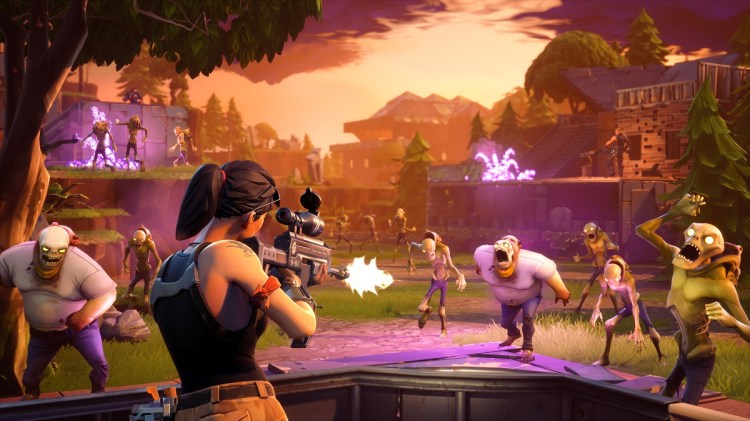Epic Games has evolved over the past few years from a game studio that makes one game at a time to a big self-publisher that works on multiple projects — including the Unreal Engine game tools. And one of the biggest titles in its new batch of games is Fortnite, a zombie defense game where you have to harvest resources, build a fort, and defend it against a horde of postapocalyptic enemies called Husks.
One of the architects behind Epic’s makeover is Donald Mustard, who announced in March that six games were in the works at Epic. Besides Fortnite (which debuts on July 25 on the PC and consoles), those games include Battle Breakers, Spyjinx, Paragon, Unreal Tournament, and Robo Recall.
Of those games, it seems like the third-person shooter Fortnite has been in the works forever. I’ve been playing the alpha build of Fortnite, and it’s a lot of fun. It’s also looks different from when Epic first showed it. It takes full advantage of the power of Epic’s Unreal Engine 4 game engine, but it is also stylized in a way to be more accessible. It’s also a big free-to-play game, with co-op play, 100 heroes, and more than 300 hours of gameplay experience in it now. The game begins in paid early access on July 25, and it will be free to play in 2018 when it formally launches.
I talked with Mustard, creative director at Epic, and executive producer of Fortnite, at a recent preview event. We talked about the new Epic, why Fortnite took so long, and how the team finally brought it into its home base.
June 5th: The AI Audit in NYC
Join us next week in NYC to engage with top executive leaders, delving into strategies for auditing AI models to ensure fairness, optimal performance, and ethical compliance across diverse organizations. Secure your attendance for this exclusive invite-only event.
Here’s an edited transcript of our interview.
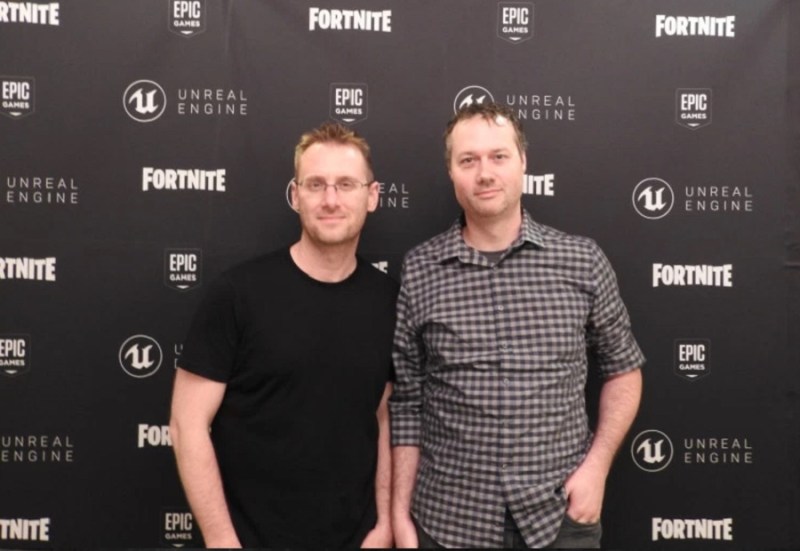
Above: Donald Mustard and Zak Phelps of Epic Games.
Donald Mustard: We’ve evolved what Epic is over the last five years or so, changing from a small development studio that makes one game at a time to a large developer that also publishes some games and has its own back end operations and marketing wing so we can actually have six games in development at once, publish them independently, and operate them for years at a time. That’s what Epic has become.
We looked at the future and saw that the future is games as a service. The future is free-to-play. The future is VR and AR and the metaverse. That’s what Tim was talking to you about last week. How do we fundamentally transform Epic to be positioned so that not only are we making the games that pave the way for the future, but making the technology that paves the way for the future – not just in games, but in all sorts of entertainment and other applications.
Paragon is out and growing. We’re at six million players right now. Battle Breakers is in soft launch in Australia. It’ll come out globally in just a few months. Robo Recall is out and widely heralded as the greatest piece of VR ever created. We’re happy with that. That was our goal. How do we create the bleeding edge of VR right now and show that our technology can do that? Spyjinx is well under way. Hopefully we’ll be able to talk about that the next time we meet. We have a small team working on Unreal Tournament, and then there’s Fortnite.
I hope you can see from what we showed today that Fortnite has come into its own. It’s ready. We’re ready to begin operating it at a large scale.
GamesBeat: Would you say that it’s like modernizing Epic?
Mustard: It is. Luckily, Tim is very smart. He’s very forward looking. That’s one of the reasons why we were so excited to partner with Tencent. As we looked at the market five years ago, the traditional boxed game model wasn’t going to hold. And who’s to say that even the current model we’re shifting to is going to hold, but it’s certainly the model we’re seeing currently.
GamesBeat: EA’s earnings were all about their live services.
Mustard: Right. Five years ago we were a company with under 100 employees that made one game at a time and happened to have an engine we licensed out. Now we’re more than 500 people and we have all these games, all this enterprise work. We’re much better positioned for the future. It’s taken us five years to change, to make that transformation. Not just to turn the ship, but to transform us.
Fortnite has been the tip of the spear the entire time. When we started prototyping it, it was on Unreal Engine 3. As we realized our ambitions for the game, and our hopes for the game, we knew we didn’t have the technology to make that yet. We needed to make a new engine not just to service the future, but that could showcase what we wanted to do with this game – to make these dynamic worlds, fully destructible, randomly generated. These were massive things that we needed new technology to do. Fortnite paved the way for that, and for our live operations back end.
Paragon is currently out in open beta, but we’ve been operating Fortnite in a closed alpha using our back end for about 22 months. That’s been operating continuously the whole time with real players, stress testing that back end. We had to stand that up to even work on Fortnite. We had to build a publishing wing and marketing department. Everything we had to do to transform Epic into a publisher. Our ambition is to be independent, and to be able to do that on our own without having to rely on an external partner.
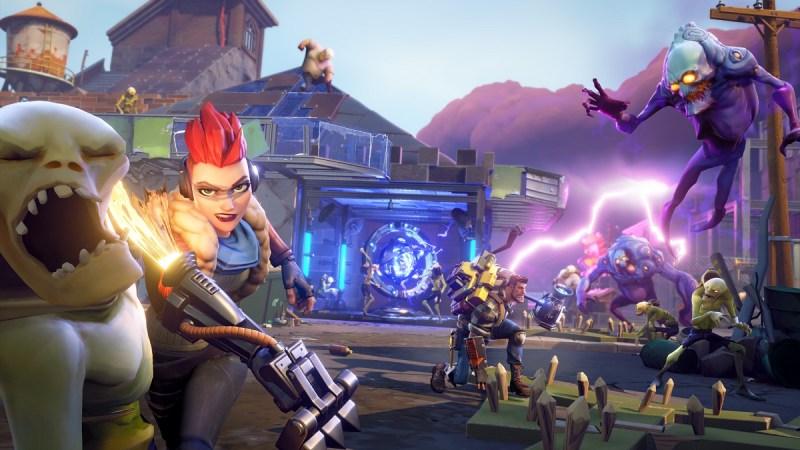
Above: Fortnite
GamesBeat: So this game was the guinea pig for the new Epic?
Zak Phelps: To some extent? I think Paragon has proven out a set of things that we needed to do. Because it released before Fortnite, that’s helped establish some of the frameworks and foundations, especially for publishing and live operations, our infrastructure pieces. Now it’s paved the way for Fortnite to get to where we’re at. We gave them a boost in the technology they needed to accomplish their goals, and now we’re getting a boost from them in the infrastructure and customer service and live ops we need to ship Fortnite. We wouldn’t have gotten here without Paragon doing what it did.
GamesBeat: Fornite looks very different from it did at first. The art is more realistic than the last time we saw it.
Phelps: Our goal has always been to create a game that was accessible and stylized. What if Pixar did The Walking Dead? One of the things we looked in the revision was the characters. We took a long look at them and really wanted to get the heroism that we were hoping for in the game, to be able to pull that together. That’s where we re-envisioned all the core characters, establishing the heroes and putting together some solutions to be able to create hundreds of heroes. The game we have today now has 100-plus heroes, and that’ll continue to grow after we launch. We’re excited about that. We think that heroism—it just fulfills the core of what Fortnite is.
GamesBeat: What else can you point out that’s new about it?
Phelps: A lot of things we’ve invested time and effort into, we haven’t yet demonstrated the depth of them, because we wanted to give you the opportunity to play the game first and see just how big it is now. We have 300-plus hours of experience. We have a quest system. We have a large shared world where all players can basically play together. We have a skill tree with 300-plus nodes in it. We have our expedition system, our collection book. The entire game is now based on a card system, where you can get cards and level them up. Everything’s a card, everything from the heroes to the traps to the weapons to defenders that you can use in the world or survivors you can save and bring back to your outpost.
We have a persistent building space now called the outpost. You go into the world, collect things, bring them back to the outpost, and build your fort. That leads to the core progression of the game as you unlock those things. As you play through, you unlock additional regions of the game where you get to build new outposts and find new terrain.
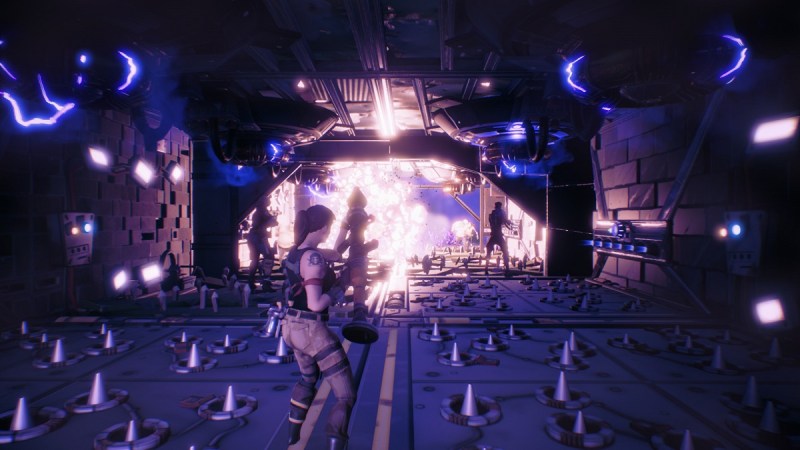
Above: Building traps is one of the delights of Fortnite.
Mustard: This isn’t a typical game development. With the unique path of Fortnite—you’ve been exposed to it a little more. Typically, when you design a game you start by building the core loop. The core loop in Fortnite has always been harvesting resources, building a defense, and then fighting to defend it. Regardless of the art style, all the other features, that’s been there for a very long time.
Once you have that core loop—let’s say we’re talking about Mario, the core loop of running and jumping and smashing through the environment. Then you start to build all the rest of the world and the game around that. The corollary with Fortnite—what’s been so exciting for years, and what’s taken us all those years, is building the rest of the mechanics and the rest of the game around it, so it’s a robust game that supports that core loop. Every game I’ve ever built, that’s been the process.
GamesBeat: Would you say it’s more MMO-like now? Is there an ongoing mission or meaning to what all those players do together?
Phelps: There’s a core story that provides both a campaign solo experience and a cooperative experience. But all the players who play together progress their stories together. It’s very MMO-like in that sense.
Mustard: It has a very deep and robust metagame – crafting mechanics, collection mechanics, similar to what you’d find in an RPG.
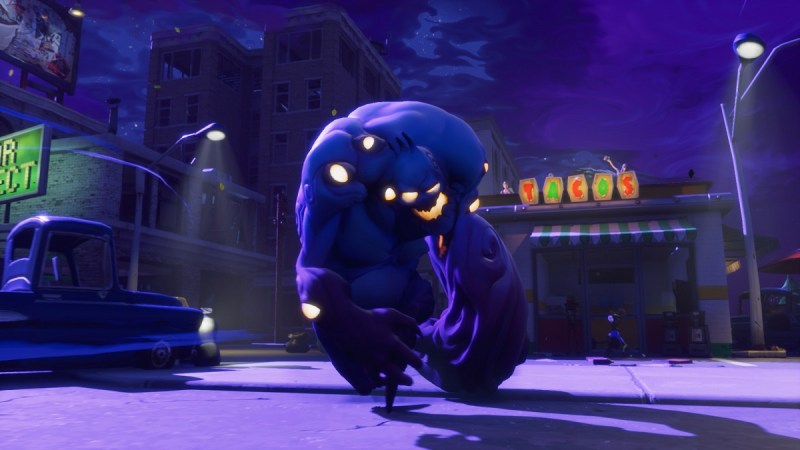
Above: The Smasher is a tough enemy in Fortnite.
GamesBeat: You’re launching on July 25. What stage will the game be at on that day?
Phelps: We’ll be on PC, Mac, Xbox One, and PlayStation 4. We’re going to call that paid early access. We’ll have different pricing packs, starting at $39.99 to get into the game. We’ll do that for a period of time. We’ll roll out the game to be fully free to play in 2018. It’s designed to be free to play and it’ll operate that way over its lifespan.
Mustard: We’re committed to that. When you look at the landscape—we’re not the first, but you’re going to see many more very high end, triple-A, robust games that are free to play, that are service-based games, that will be very successful and live for a long time. We hope that Fortnite will be one of those games.
GamesBeat: Do you have an opportunity to do things like H1Z1 has, where you have these massive-scale fortresses and battles? Or is it always meant to be a smaller-scale experience, where you’re defending relatively small spaces?
Phelps: The outposts can have more than 3,000 pieces built into them. In our alpha testing we’ve seen players build incredibly large fortresses and defend them. At the apex of the game, in Twin Peaks, the requirements for those defenses are beyond the comprehension of someone just starting the game. They’re incredibly difficult. They require an incremental level of building skill to accomplish.
Those battles are still four players, but the person whose outpost it is can have up to five other defenders they acquire during gameplay. Essentially you can have up to nine different guns on the wall at the same time, able to take part in these battles.
Mustard: As you move through the game, you’re building your central, persistent outpost. Over time, as you gain more materials, you’re building this uber-crazy-ultimate base, this huge fortress. You can invite other players to come to that and defend, or you can go to theirs. It’s amazing. Even some of the stuff we’ve seen from the community—we didn’t have time to show it all today, but it’s pretty astounding, the things people are building with these tools.
Again, our intent with the game is to continue to evolve it over time. Our focus right now is on PvE, but it doesn’t meant that, in the future, we don’t have massive plans for all sorts of other fun modes. But yeah, these crazy bases people are able to make are just astounding. That’s definitely one of the opportunities you saw.
GamesBeat: Was there a kind of Minecraft inspiration at the beginning?
Mustard: In a lot of ways that’s not wrong. In a lot of ways, this is—if you love Minecraft, and you also love shooting, this is the game. You can come in and have a very rich RPG experience with very deep Minecraft-esque building.
Phelps: It’s building with a purpose. That’s the core of what’s fun about Fortnite. The initial modes, some of the initial gameplay we showed two years ago, that had some smaller bases, and that’s what we showed in the demo today. But those large bases are something that—we’d gotten feedback very early on that that was something players were very excited about. We wanted to make sure to find a way to enable that.
GamesBeat: It’ll be interesting to see if you get to the metaverse through Fortnite.
Mustard: There’s definitely underlying technology in Fortnite and in Spyjinks and even in Paragon that’s made with an eye toward a future that would look like that. The metaverse is going to happen. Our intent is that Unreal will be the technology that builds it. That’s it. We’re going to make it happen.
As we think of cool games we can make and technology we want to push—that’s why having a portfolio of games, as opposed to just one game, really helps us. We’re not just making cool games that we think audiences will want to play, but we’re also saying, “What kind of technology does our engine need to have to pave the way to the future?” Not just for games, but for other things. What kind of technologies do our licensees need to make this crazy stuff? Fortnite has innovated a lot of technology that’s benefited not just our internal games, but so many licensees using Unreal 4.
That’s our secret. We don’t just build the hammer. We use the hammer. Because we use our own tools, we can make them better and better all the time.
GamesBeat: And you deal with the pain of hitting your thumb sometimes.
Mustard: That too. It does happen.
